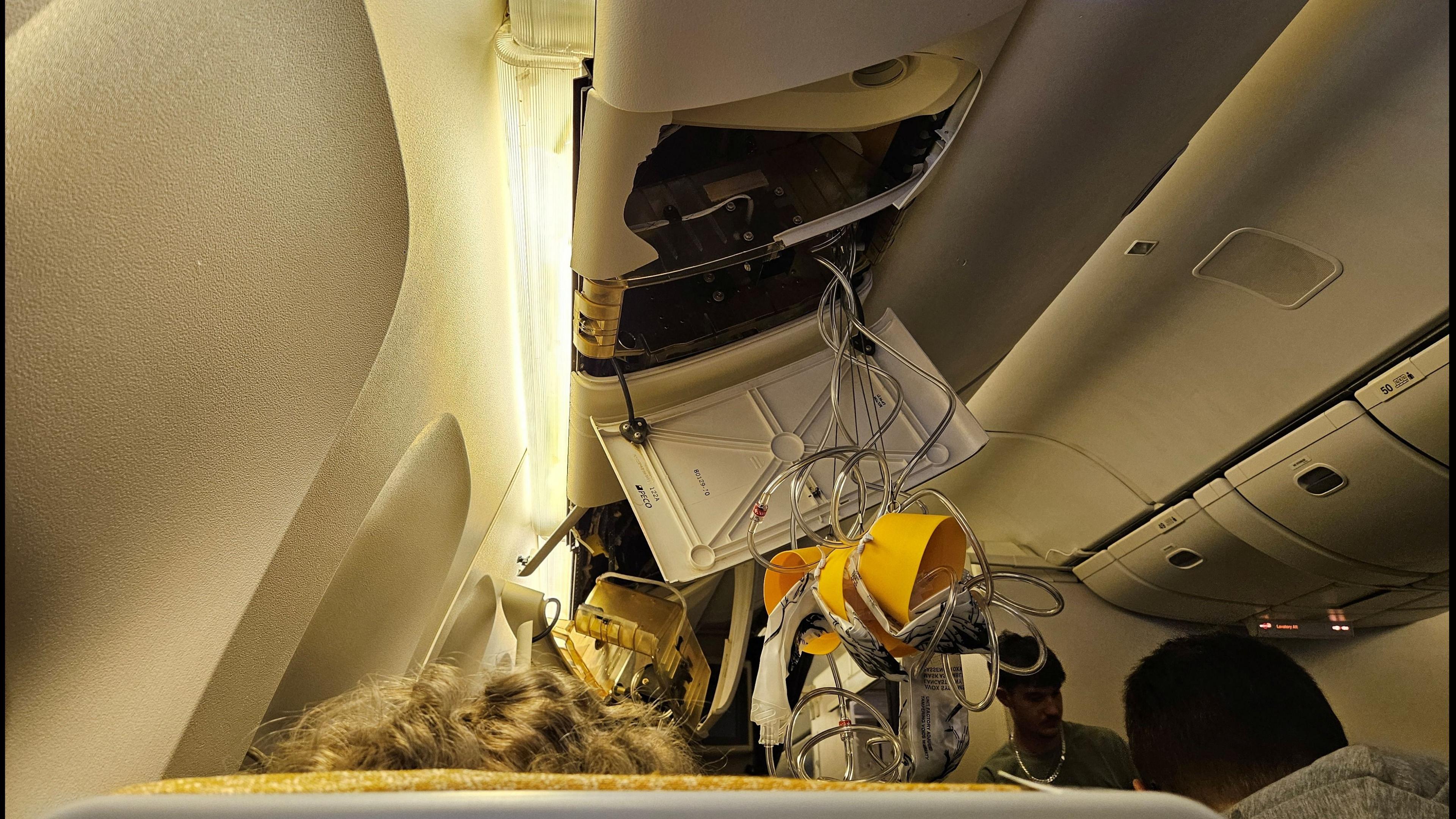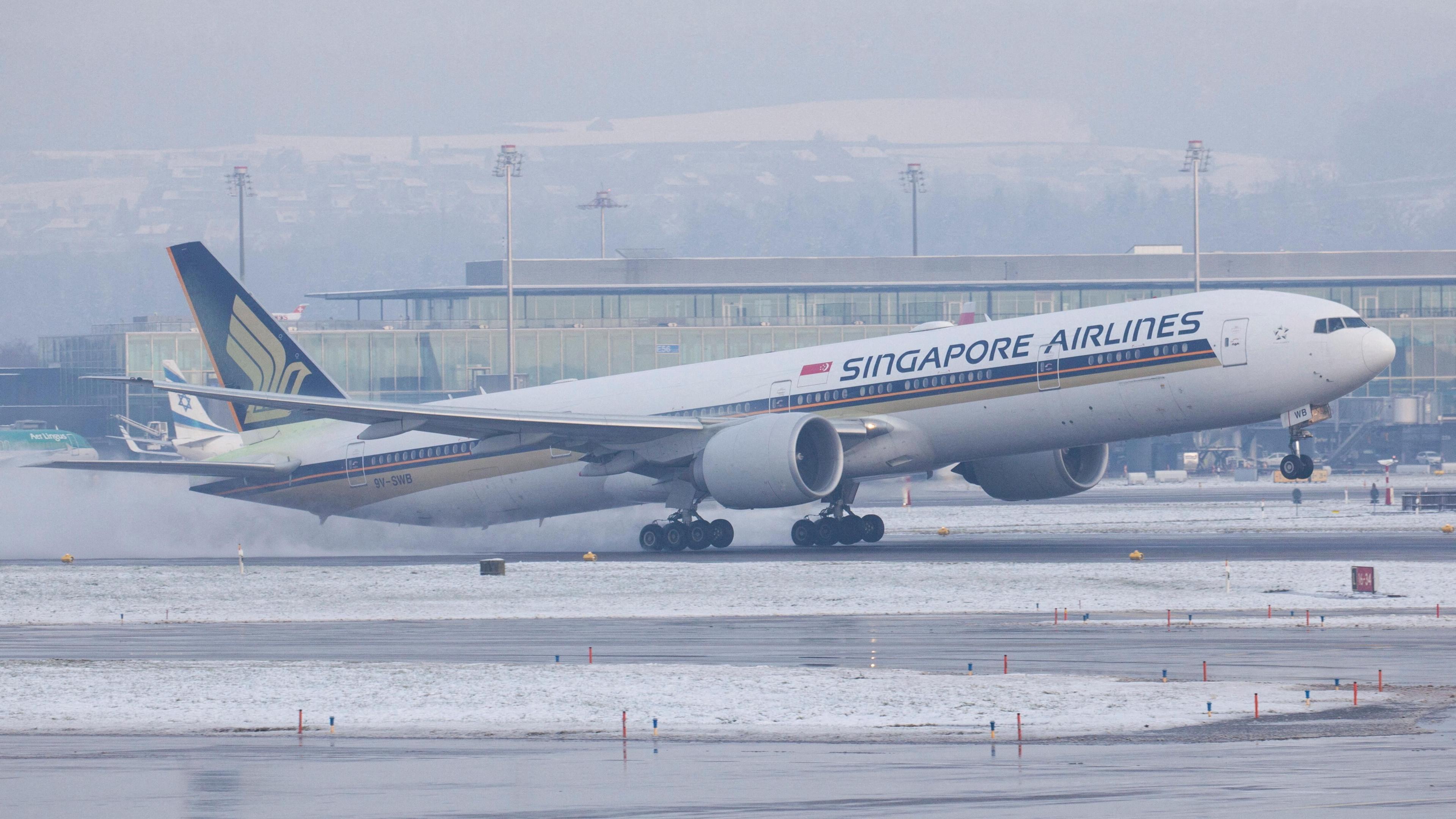Singapore Airlines plane jolted up and down for five seconds - report
Watch: How chaos onboard Singapore Airlines SQ321 unfolded
- Published
Early investigations into severe turbulence that hit a Singapore Airlines flight last Tuesday reveal the plane accelerated rapidly up and down, and dropped around 178ft (54m) over 4.6 seconds.
One British passenger died and dozens more were injured when the London-Singapore flight encountered the turbulence over Myanmar and was diverted to Thailand.
Singaporean investigators have extracted data stored in the flight data recorder and cockpit voice recorder of the aircraft.
Singapore Airlines said it was cooperating with investigators and supporting affected passengers and crew, including with medical and hospital expenses.
The Transport Safety Investigation Bureau's (TSIB) preliminary findings suggest there were rapid accelerations upwards and downwards - causing injuries to those without seatbelts, who rose out of their seats and fell back down.

Food and drink items, including kettles, were pictured on the plane's floor after it met turbulence
The agency said the flight operated as normal until it probably flew over an area of "developing convective activity" while passing over the south of Myanmar at 37,000ft (11,300m).
At 07:49:40 GMT, after a period of upward acceleration, it quickly accelerated downwards over 0.6 seconds, which presumably "resulted in the occupants who were not belted up to become airborne".
Then the plane accelerated up again for four seconds, meaning those who were airborne fell back down.
The effect can be likened to "putting an egg inside a metal box, then shaking the box up and down", aviation expert Dr Guy Gratton told the BBC.
"After the pilots were informed by the cabin crew that there were injured passengers in the cabin, the decision was made to divert to Suvarnabhumi Airport, Bangkok, Thailand," the report continued.
Approximately 17 minutes after the turbulence event, the pilots were able to make a "controlled descent from 37,000ft", it said, adding the aircraft did not encounter any more severe turbulence during its diversion to Bangkok.
The pilots also requested for medical services to meet the aircraft on arrival.
TSIB, which operates under Singapore's transport ministry, said its investigations were ongoing.
There were 211 passengers and 18 crew on board the Boeing 777-300ER aircraft, according to Singapore Airlines.
Geoff Kitchen, 73, died from a suspected heart attack on board, while 104 other passengers were taken to Bangkok's Samitivej Hospital for treatment.
Ali Bukhari, 27, who was seated with his wife Ramiza, told the BBC the aircraft went into "straight freefall".
"It was terrifying. It's just like going down a vertical rollercoaster," he said.
"Oxygen masks had all come out, parts of the interior of the plane were damaged… I thought that was from the force of the turbulence but a lot of it was just because everyone who wasn't wearing a seatbelt flew right into the air and hit the ceiling.
“We saw blood on the ceiling… It was just complete havoc. A lot of people were on the floor."

Singapore Airlines said it was committed to supporting crew members and passengers who were onboard Tuesday's flight.
"This includes covering their medical and hospital expenses, as well as any additional assistance they may need," the airline said on social media.
"The safety and well-being of our passengers and staff are our top priorities.
"We deeply appreciate the invaluable assistance provided by the governments of Singapore and Thailand, as well as our many partners and the medical teams in both countries and around the world."
Last Thursday, the director of Samitivej Srinakarin Hospital said staff initially treated six people for skull and brain injuries, 22 for spinal injuries, and 13 for bone, muscle and other injuries.
"We have never treated people with these kinds of injuries caused by turbulence," Adinun Kittiratanapaibool told reporters.
As of Wednesday, 42 passengers who were on the flight were still in Bangkok, according to Singapore Airlines - of which 26 were in hospital receiving medical treatment.
Watch now on iPlayer
- Published28 May 2024

- Published22 May 2024

- Published23 May 2024
